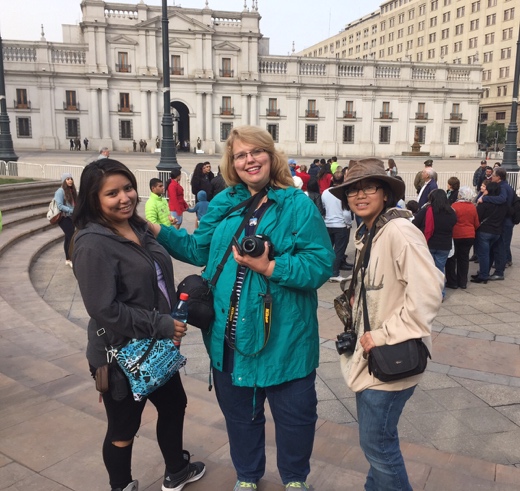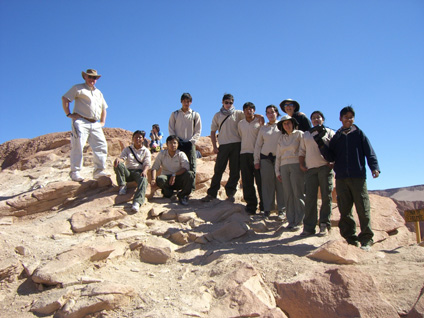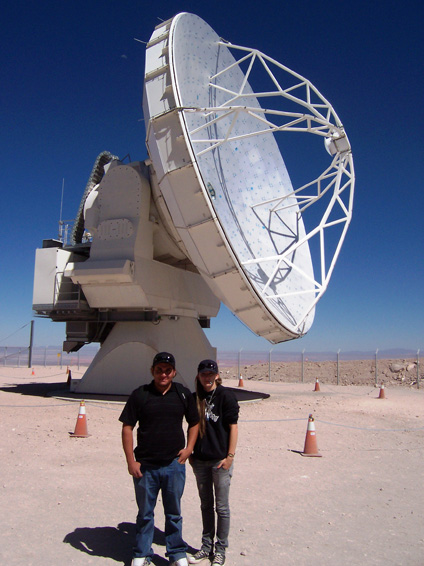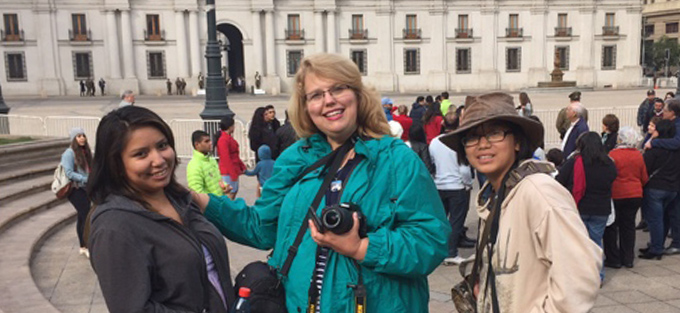Sister Cities Begins: School Exchange Between Neighbors of ALMA in Chile and the VLA in the U.S.
29 July, 2016 / Read time: 4 minutes
This week, with the goal of exchanging experiences, students and teachers from the schools neighboring the emblematic Atacama Large Millimeter/submillimeter Array (ALMA) and Karl G. Jansky Very Large Array (VLA) observatories began to insert themselves into the scholastic and cultural realities of their respective host countries as part of the Sister Cities program, sponsored by the United States’ National Radio Astronomy Observatory (NRAO) and Associated Universities Inc. (AUI).
This Thursday, July 28th, two 11th-grade students, Madeline Stuteville and Samantha Secatero, and math teacher Britt Verstegen, from the Magdalena Secondary School (New Mexico, USA), located near the VLA, landed in Chile. The group will live for one month in San Pedro de Atacama (Region of Antofagasta, Chile), the neighboring town of ALMA, where they will stay with the Likan Antai C-30 school community.
One month later, on September 1st, Cristián Cruz and Diana Manríquez, two students and physics teacher Carola Torrejón, from the Likan Antai School will leave for the United States to live the reverse experience.
“Both Magdalena and San Pedro, though small, rural communities, benefit from their proximity to cutting-edge astronomical research facilities. This is a common link that brings them educational opportunities, particularly in STEM fields, that otherwise would not be available," said Mark McKinnon, NRAO's Director for New Mexico Operations.

In front of La Moneda Palace in Santiago, House of Executive Power in Chile, the Magdalena School visitors on their first day in this country. Credit: S.Cabezon (AUI/NRAO/NSF) | Download image
Vanetta Perry, Superintendent of the Magdalena Schools, said, "We are excited to participate in the Sister Cities Program with Associated Universities, Inc., ALMA, and the VLA. The opportunity to provide international scientific and cultural exchanges for our teachers and students will have life-changing effects on the participants, effects that will ripple out into our educational community and benefit all our students and staff."
In addition to their proximity to the telescopes, the two regions share high desert climates and include distinctive indigenous populations: the Alamo Navajo reservation in New Mexico and the Atacameño community in Chile.

Teachers from both establishments participating in educational activities of the tourism specialty at the San Pedro School. Credit: S. Cabezón (AUI/NRAO/NSF) | Download image
Carola Torrejón, a Physics teacher and person in charge of the Astronomy Academy at the San Pedro school, was visibly happy to have been selected for this program: “The initial task will be to make a diagnosis of the curriculum and comparative methodology, though in the long term, we wish to broaden our scope to an exchange on the visions of Worldview and Archaeoastronomy of the Navajo and Atacameño peoples, broadening it to music, art, and other subjects.”
The Sister Cities program began in 2006, promoting the cultural exchange between teachers and students of secondary education in the two participating educational establishments. In this latest version, the program is also promoting its teaching practices and reinforcing some learning elements that favor the areas of science, technology, engineering, and mathematics (STEM).

Students from the Magdelena Secondary School visiting the ALMA observatory. Credit: S. Cabezón (AUI/NRAO/NSF) | Download image
Furthermore, the students and educators who participated in the exchange held videoconferencing sessions with teachers and students from both locations, so as to include the greatest number of members from the two educational communities.
Now, teachers and students who participate in the exchange will visit both radio telescopes accompanied by their new classmates.
Additional information
ALMA is a partnership of ESO (representing its member states), NSF (USA) and NINS (Japan), together with NRC (Canada), NSC and ASIAA (Taiwan), and KASI (Republic of South Korea), in cooperation with the Republic of Chile. The Joint ALMA Observatory is operated by ESO, AUI/NRAO and NAOJ.
Contacts
-
Nicolás Lira
Education and Public Outreach Coordinator
Joint ALMA Observatory, Santiago - Chile
Phone: +56 2 2467 6519
Cel: +56 9 9445 7726
Email: [email protected]
-
Charles E. Blue
Public Information Officer
National Radio Astronomy Observatory Charlottesville, Virginia - USA
Phone: +1 434 296 0314
Cel: +1 202 236 6324
Email: [email protected]

